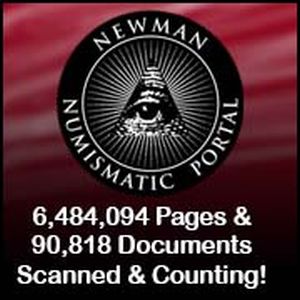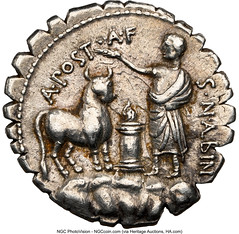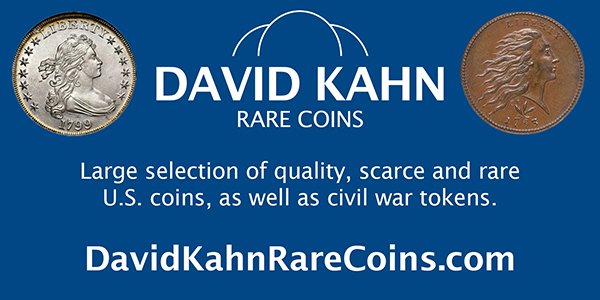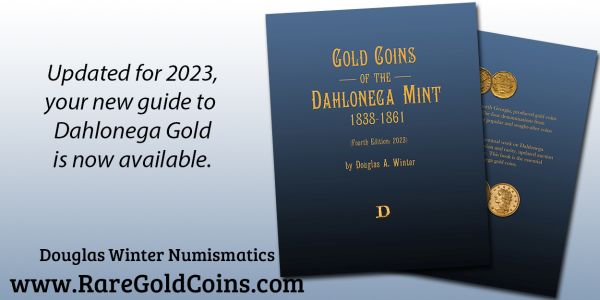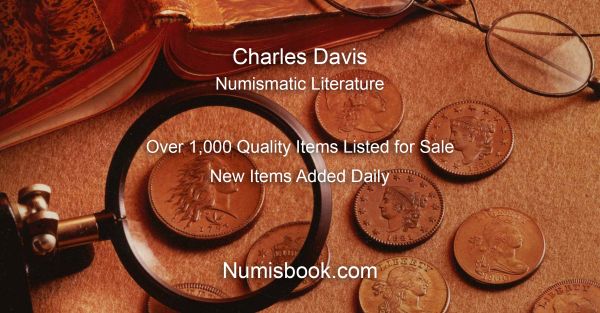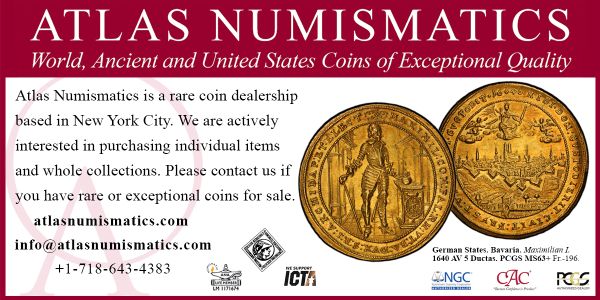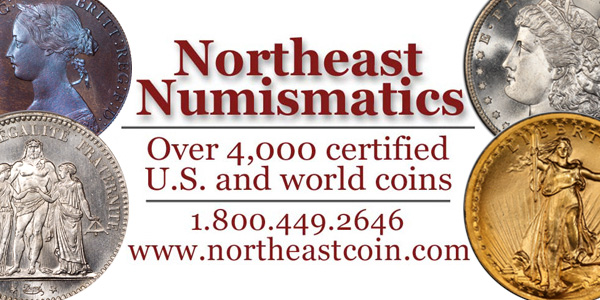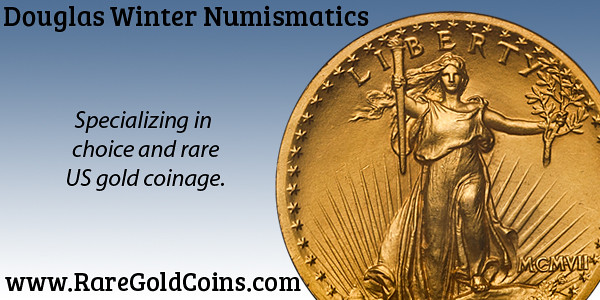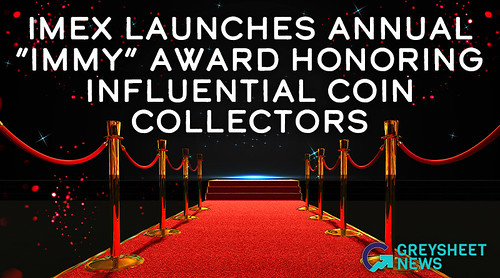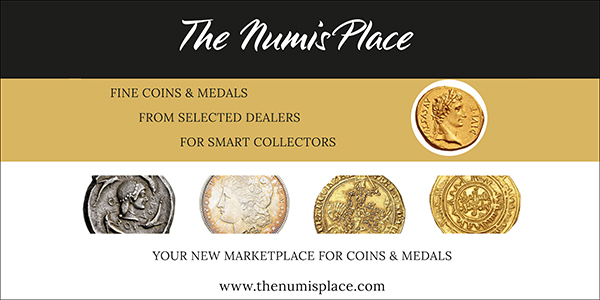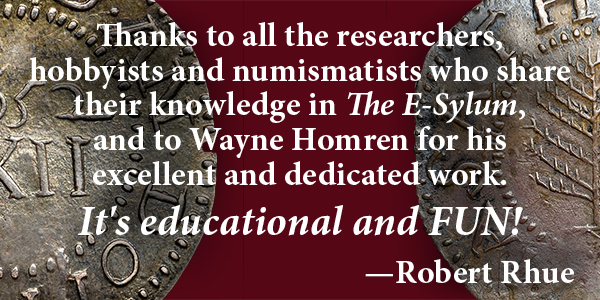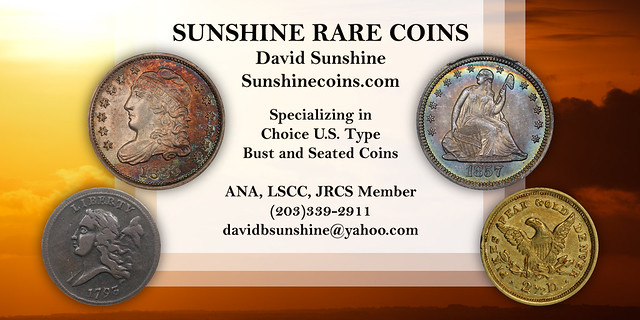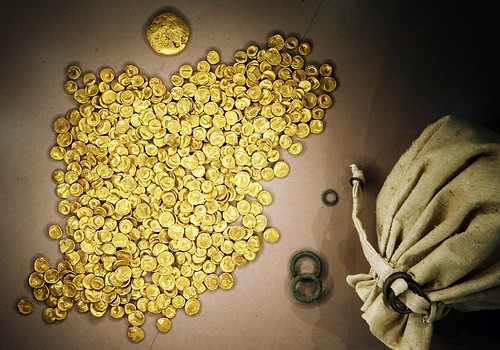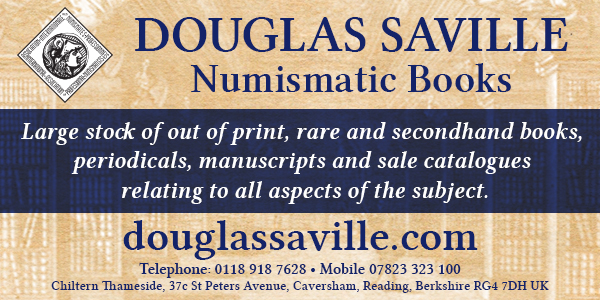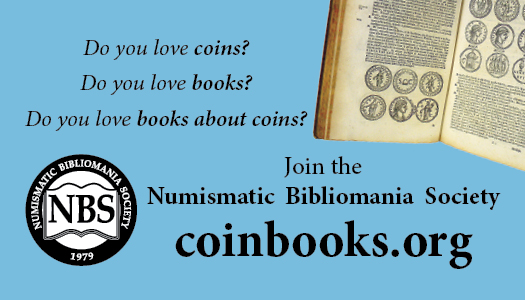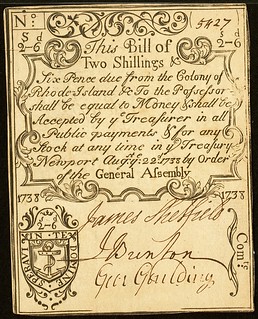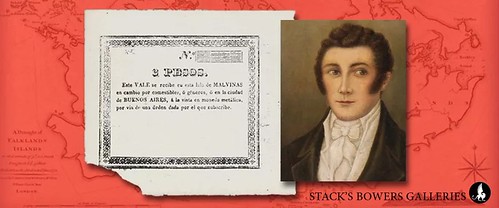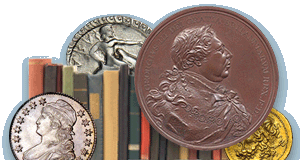
Visit our NBS Sponsors
About UsThe Numismatic Bibliomania Society is a non-profit association devoted to the study and enjoyment of numismatic literature. For more information please see our web site at coinbooks.org SubscriptionsThose wishing to become new E-Sylum subscribers (or wishing to Unsubscribe) can go to the following web page link MembershipThere is a membership application available on the web site Membership Application To join, print the application and return it with your check to the address printed on the application. Print/Digital membership is $40 to addresses in the U.S., and $60 elsewhere. A digital-only membership is available for $25. For those without web access, write to: Jeff Dickerson, Treasurer AsylumFor Asylum mailing address changes and other membership questions, contact Jeff at this email address: treasurer@coinbooks.org SubmissionsTo submit items for publication in The E-Sylum, write to the Editor at this address: whomren@gmail.com BUY THE BOOK BEFORE THE COINSale CalendarWatch here for updates! |
- WAYNE'S WORDS: THE E-SYLUM AUGUST 3, 2025
- 2025 NBS SYMPOSIUM "MENDACIOUS" PRANKSTER REVEAL
- NEW BOOK: GREEK COIN ART
- NEW BOOK: THE KUNINDAS AND THEIR COINS
- NEW BOOK: WAR DOG
- ORIENTAL NUMISMATIC SOCIETY SUMMER 2025
- PAT ALEXANDER (1947-2025)
- WILLIAM EDWARDS METCALF (1947-2025)
- STACK'S BOWERS: Q. DAVID BOWERS TO RETIRE
- PANS EAGLET ADDED TO NEWMAN PORTAL
- VIDEO: THE ENGRAVING PROCESS
- NOTES FROM E-SYLUM READERS: AUGUST 3, 2025
- THE PERKINS PRINTING AND ENGRAVING PLANT
- VOCABULARY TERM: RIM
- IMEX LAUNCHES ANNUAL "IMMY" AWARD
- FRED HOLABIRD ON TOM LEHRER, MUSIC AND LAUGHS
- HERITAGE AUCTIONS: ROMAN REPUBLIC ANCIENT COINS
- STACKS BOWERS: 1836 JUDD-60 GOBRECHT DOLLARS
- CELTIC GOLD HOARD THEFT CONVICTIONS
- THE MIDGARD SERPENT TYPE PENNY
- THE COMMON CENTS ACT
- THE CENT'S MANY USES
- CNG ISSUES 50TH ANNIVERSARY MEDAL
- 1738 RHODE ISLAND RARITY
- 1862 PINETUCKEY GOLD MINES SCRIP NOTE
- ARGENTINE-FALKLAND ISLANDS PAPER MONEY
- LOOSE CHANGE: AUGUST 3, 2025
- ABOUT THIS ISSUE: AUGUST 3, 2025
Content presented in The E-Sylum is not necessarily researched or independently fact-checked, and views expressed do not necessarily represent those of the Numismatic Bibliomania Society.
WAYNE'S WORDS: THE E-SYLUM AUGUST 3, 2025
 New subscribers this week include:
Michael Crowder, courtesy Steve Davis;
Buck Creel, courtesy of Terry Hess;
Rob Tucker, courtesy of Garrett Ziss;
and Paul Hollis.
Welcome aboard! We now have 7,248 subscribers.
New subscribers this week include:
Michael Crowder, courtesy Steve Davis;
Buck Creel, courtesy of Terry Hess;
Rob Tucker, courtesy of Garrett Ziss;
and Paul Hollis.
Welcome aboard! We now have 7,248 subscribers.
Thank you for reading The E-Sylum. If you enjoy it, please send me the email addresses of friends you think may enjoy it as well and I'll send them a subscription. Contact me at whomren@gmail.com anytime regarding your subscription, or questions, comments or suggestions about our content.
Next week we'll attempt to switch over to MailChimp as our email provider. On Monday August 4th, the 27 of you who are already on the MailChimp list should get a second copy of this email. If that experiment works I'll work on moving everyone else over and we'll publish our first full MailChimp issue soon, likely August 10th. Thank you for your patience during this upgrade.
This week we open with a 2025 NBS Symposium topic, three new books, a periodical, two obituaries, a retirement, updates from the Newman Numismatic Portal, and more.
Other topics this week include Greek coin art, Roman Republic coins, the Dickin Medal, Jacob Perkins, auction previews, the Common Cents Act, and paper money from Rhode Island, Pinetucky, and the Falkland Islands.
To learn more about the "Mendacious" prank, the Kunindas and their coins, Judy, the prisoner of war dog, Q. David Bowers, John Mercanti, Holey Dollars, rims, Gobrecht silver dollars, Midgard Serpent pennies, Classical Numismatic Group, and Dealing With Nonsense Online, read on. Have a great week, everyone!
Wayne Homren
Editor, The E-Sylum
2025 NBS SYMPOSIUM "MENDACIOUS" PRANKSTER REVEAL
Numismatic Bibliomania Society President Len Augsburger submitted this announcement of one of the NBS Symposium topics at the upcoming ANA convention in Oklahoma City. -Editor
"Mendacious" Prankster Revealed
 In 1992, American bibliophiles received a one-page flyer in the mail that advertised a numismatic literature sale to be held April 1, 1992 in Fort Worth, TX, at "1204 Magnolia," which just happened to be the former address of the coin dealer B. Max Mehl. The announcement hinted the material was of great value and that the cataloger was not completely familiar with the significance of the items. The circular noted "Many old catalogs in beautiful leathers, though a number marked up with prices and various names."
In 1992, American bibliophiles received a one-page flyer in the mail that advertised a numismatic literature sale to be held April 1, 1992 in Fort Worth, TX, at "1204 Magnolia," which just happened to be the former address of the coin dealer B. Max Mehl. The announcement hinted the material was of great value and that the cataloger was not completely familiar with the significance of the items. The circular noted "Many old catalogs in beautiful leathers, though a number marked up with prices and various names."
Numismatic book collectors, unable to verify specifics in the pre-Internet era, went into a frenzy, with some reputedly booking airfare to the event. Eventually, the ruse was found out, with the key clues being the April Fool's sale date, and the auctioneer's name ("M. N. Daycius"), which represented a phonetic pseudonym – "mendacious," or lying. A "large pile of old coin sales, a few going back to the 1820's" suggested the author was aware of the 1828 Watkins broadside, then thought to be the earliest American numismatic auction sale, a fact known only to those aware of Attinelli's 1876 Numisgraphics bibliography.
NEW BOOK: GREEK COIN ART
Peter Jones has published a new book on Greek Coin Art. Congratulations! Here's his announcement. -Editor
 One day, while attending a coin show in New York City, a dealer recognized me and asked me what I collected. I told him I did not know, but those marvelous 2,000-year-old pieces of silver were masterpieces of ancient sculpture. "Ah!" he said, "Art on coins!" I ended up learning about the fascinating world of ancient Greece, their endemic warfare, their philosophy, and their life.
One day, while attending a coin show in New York City, a dealer recognized me and asked me what I collected. I told him I did not know, but those marvelous 2,000-year-old pieces of silver were masterpieces of ancient sculpture. "Ah!" he said, "Art on coins!" I ended up learning about the fascinating world of ancient Greece, their endemic warfare, their philosophy, and their life.
The book, Greek Coin Art, shows many of the commonest available Greek coins as full page color pictures. The layout is mainly a full page coin photograph on one page with the history behind it on the page opposite. It starts with the "grand tour" (the way collectors classify the different parts of the ancient Greek world), denominations, and pay in ancient times.
Subsequent chapters cover: Non-Greek Europe, Southern Italy and Sicily, Macedonia, Thrace, Thessaly Central Greece and the Peloponnese, Crete, Asia Minor (present-day Turkey), Cyprus and the Levant, The Achaemenids (ancient Persia), The Seleukid Empire, The Parthian Empire, Greco-Baktrians, Indo-Greeks, Ptolemaic Egypt.
NEW BOOK: THE KUNINDAS AND THEIR COINS
In a Facebook post, Manish Verma of the Hinduja Foundation described their recently published book, The Kunindas and their Coins. Thanks to Paula Turner, editor of the Journal of the Oriental Numismatic Society (JONS) for notice of the new book. See the article elsewhere in this issue for more information on the latest JONS issue, which includes a review. -Editor
The Kunindas and their Coins by Shri Devendra Handa.
(Heritage of India Series)
Publisher: Hinduja Foundation
ISBN: 978-81-982180-2-5
Price: 3000/-
 Known from literary sources like the epics, Puranas, classical and specialized texts under various names, the republican Kunindas continued to strike their coins in silver, copper or some alloys in the name of Amoghabhuti. The silver specie based on the module of the Indo-Greek hemi-drachms but purely Indian in form and devices are a visual feast to the eyes. Having purely indigenous types their preference for an alien weight-standard is an interesting feature.
Known from literary sources like the epics, Puranas, classical and specialized texts under various names, the republican Kunindas continued to strike their coins in silver, copper or some alloys in the name of Amoghabhuti. The silver specie based on the module of the Indo-Greek hemi-drachms but purely Indian in form and devices are a visual feast to the eyes. Having purely indigenous types their preference for an alien weight-standard is an interesting feature.
The objects were first discovered by canal diggers near Behat, a location in the Saharanpur district (in modern-day Uttar Pradesh, India) in 1834. These objects are now known from numerous hoards and stray finds, currently in the prized possession of collectors, museums, and institutions.
Hoards refer to large collections of objects that are often buried together, while stray finds refer to items discovered randomly, not in structured archaeological excavations.
NEW BOOK: WAR DOG
We often discuss recipients of the Dickin Medal, honoring animals who serve in war. A new children's book tells the incredible story of one of them - Judy, a resourceful Royal Navy dog who saved lives and accompanied crewmembers taken as prisoners of war by Japanese forces. -Editor
 The True Story of Judy, hero of WW2
The True Story of Judy, hero of WW2
My debut picture book is the true story of one dog's incredible bravery, set in the Second World War in the South–East Asian theatre of the Pacific War. After the fall of Singapore, Judy and her crew become prisoners of war.
As the ship's mascot, Judy has many duties. She catches rats, watches out for soldiers who may fall overboard, and she listens out for danger. Judy loves her crew, and they love her.
ORIENTAL NUMISMATIC SOCIETY SUMMER 2025
The Summer 2025 issue of the Journal of the Oriental Numismatic Society has been published. -Editor
 Journal of the Oriental Numismatic Society
Journal of the Oriental Numismatic Society
260 Summer 2025
Copper coins of Aulikara ruler Yasodharman-Vish?uvardhana
Devendra Handa
Transition from Pahlavi to Kufic: numismatic evidence from Zoroastrian and Muslim governors in the
early Islamic period
Kiarash Gholami
Attribution of coins to the queens of the Utpala dynasty of medieval Kashmir
Gul Rahim Khan
The rebel issue of Giyath al-Din Bahadur Shah (720 H–724 H)
Arup Kumar Saha
Kollam's maritime trade relations with Sri Vijaya: numismatic evidence
Beena Sarasan
ONS News 26
Book review and notice
PAT ALEXANDER (1947-2025)
Earlier this week Secretary-Treasurer John Janeczek passed word that "The New York Numismatic Club is saddened to announce the death of our member Pat Alexander on Monday, July 28, 2025, after a month-long illness. Pat is survived by her husband of 47 years, Past President David Alexander."
E-Sylum Feature Writer and American Numismatic Biographies author Pete Smith submitted this article. Thank you. NOTE: DTA = David Thomason Alexander. Thanks to Len Augsburger, I added a photo from her online obituary, linked below. She died on July 27, 2025. -Editor
 She was born as Patricia Ann LaBranche in Dayton, Ohio, on March 29, 1947. Her parents were
Roge Philip LaBranche (1917-1970) and Delight Aileen Durbin LaBranche (1917-1982). Roge
was a toolmaker and part owner of Dayton Industrial Supply Co.
She was born as Patricia Ann LaBranche in Dayton, Ohio, on March 29, 1947. Her parents were
Roge Philip LaBranche (1917-1970) and Delight Aileen Durbin LaBranche (1917-1982). Roge
was a toolmaker and part owner of Dayton Industrial Supply Co.
Pat graduated from Meadowdale High School in Dayton. She attended Ohio University in Athens and Wright State University in Dayton. She studied Business Administration combined with counseling psychology.
WILLIAM EDWARDS METCALF (1947-2025)
American Numismatic Society Executive Director Dr. Ute Wartenberg Kagan submitted this note on the passing of former Chief Curator Bill Metcalf. Sorry to hear this news. -Editor
 It is with great sadness that the American Numismatic Society announces the death of William E. Metcalf, who passed away at the age of 77 on 2 August 2025. Former ANS Chief Curator and one of the most distinguished numismatists in the field of Roman numismatics, he worked at the ANS from 1975 to 2000. In 2024, he received the Society's Archer M. Huntington Award for Excellence in Numismatic Scholarship. His many friends and colleagues at the Society deeply mourn his passing and will cherish his memory with enduring respect and affection. A full obituary detailing his distinguished life and career will appear at a later date.
It is with great sadness that the American Numismatic Society announces the death of William E. Metcalf, who passed away at the age of 77 on 2 August 2025. Former ANS Chief Curator and one of the most distinguished numismatists in the field of Roman numismatics, he worked at the ANS from 1975 to 2000. In 2024, he received the Society's Archer M. Huntington Award for Excellence in Numismatic Scholarship. His many friends and colleagues at the Society deeply mourn his passing and will cherish his memory with enduring respect and affection. A full obituary detailing his distinguished life and career will appear at a later date.
To read the earlier E-Sylum article, see:
METCALF WINS 2024 ANS HUNTINGTON AWARD
(https://www.coinbooks.org/v27/esylum_v27n30a11.html)
STACK'S BOWERS: Q. DAVID BOWERS TO RETIRE
Stack's Bowers announced that after seven decades of research, dealing, and involvement in the numismatic auction industry, Q. David Bowers will be retiring. -Garrett
After over seven decades in the hobby, Stack's Bowers Galleries announces the well-deserved retirement of founder Q. David Bowers. Since the 1950s, numismatics has benefitted immensely from Dave's unsurpassed expertise, deep passion and enthusiastic involvement in the coin hobby. There is not a single collector, dealer or numismatic organization that does not know the name Q. David Bowers, understand the significance of his career, and appreciate his enormous contributions to numismatics. Brian Kendrella, Stack's Bowers Galleries president, stated: "Dave has greatly impacted numismatics over the past seven decades and will continue to do so for many years to come. He has been a wonderful mentor to many of us, and his leadership and guidance have been invaluable. We wish Dave the best in his well-deserved retirement."
Greg Roberts, Stack's Bowers Galleries CEO, said, "Dave has been a colleague and mentor to me for over 40 years. He is a true numismatic genius and friend. I wish him the very best in this next chapter."
PANS EAGLET ADDED TO NEWMAN PORTAL
The latest addition to the Newman Numismatic Portal is the Polish-American Numismatic Society's PANS Eaglet. Project Coordinator Len Augsburger provided the following report. -Editor
PANS Eaglet Added to Newman Portal
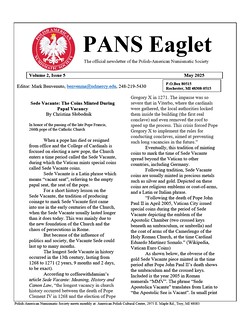 The Polish-American Numismatic Society, established in 1981, is an educational association dedicated to preserving and sharing knowledge pertaining to Polish and United States history and numismatics, world coins, tokens and medals. The group meets monthly in Troy, MI and sponsors two annual shows, in conjunction with the Windsor Coin Club (February) and also with the Huron Valley Numismatic Society (August).
The Polish-American Numismatic Society, established in 1981, is an educational association dedicated to preserving and sharing knowledge pertaining to Polish and United States history and numismatics, world coins, tokens and medals. The group meets monthly in Troy, MI and sponsors two annual shows, in conjunction with the Windsor Coin Club (February) and also with the Huron Valley Numismatic Society (August).
The PANS Eaglet began publication in 2024 and is edited by Mark Benvenuto. Back issues are now archived on Newman Portal. The Eaglet includes coverage of both historical and modern Polish numismatics, in addition to monthly news items. The inaugural issue (July 2024) noted the ANA President's Award, which recognized PANS President Lester Rosik for building bridges between the Polish, Canadian, and American numismatic communities.
VIDEO: THE ENGRAVING PROCESS
The David Lisot Video Library on the Newman Numismatic Portal can be found at:
https://nnp.wustl.edu/library/multimediadetail/522852
We highlight one of his videos each week in The E-Sylum. Here's one from 2009 with Chief Engraver John Mercanti speaking about New Technology and the Engraving Process. -Editor
NOTES FROM E-SYLUM READERS: AUGUST 3, 2025
Myron Xenos Services
Steve Davis writes:
 "I went to Ohio yesterday for Myron's memorial service and it was a wonderful tribute, there were many photo boards that showed what a fantastic personality and zest for life he had, times with his family and friends as well as in all his business ventures and in numismatics and numismatic literature. There was a great turnout of friends and family, members of the business, local and the numismatic/literature realm, I saw several out of state plates in the parking lot. This was all a testimony to the lives he touched and the kind of man he was, along with how he treated others.
"I went to Ohio yesterday for Myron's memorial service and it was a wonderful tribute, there were many photo boards that showed what a fantastic personality and zest for life he had, times with his family and friends as well as in all his business ventures and in numismatics and numismatic literature. There was a great turnout of friends and family, members of the business, local and the numismatic/literature realm, I saw several out of state plates in the parking lot. This was all a testimony to the lives he touched and the kind of man he was, along with how he treated others.
"I was fortunate enough to have sat at a table with close friends of his daughter's who related many great tales of Myron as their Softball Coach and the pool parties and vacation times with the Xenos family, according to them Myron was the "Coolest Dad", if you knew Myron at all, you could certainly envision how much fun he must have been in that context. It was a special day for a special guy.
"My heart goes out to Daryl, Stacey and Stefanie and Myron's granddaughter, Taylor; whom he always spoke of and loved bragging about. It was a very tough service and loss for me on a personal level. I have known Myron since I was a kid and he was always such a wonderful guy, made me great deals when he sold me things as a young numismatist, gave me insight, history and then later became a mentor of mine in the auction business, always being a strong bidder, buyer and consignor in virtually every sale I conducted. He recommended many clients to us and we remain forever grateful to him. My wife Lisa and I visited Rocky River many times, had the pleasure of spending time with Myron and Daryl and always looked forward to going to see them.
"Today, August 3, would have been Myron's birthday and Daryl and his daughters had a fantastic Birthday cake at the service luncheon yesterday and we all sang Happy Birthday to him. For those of us in the Great Lakes area and abroad, this will be a loss of such an icon and special person who was wise in both numismatics and numismatic literature - Rest in Peace dear friend…"
Very sad loss. Myron was bigger than life, with an outsize, outgoing personality. Being with him was always fun. He will be missed. -Editor
To read the earlier E-Sylum article, see:
MYRON G. XENOS (1938-2025)
(https://www.coinbooks.org/v28/esylum_v28n30a06.html)
Other topics this week include books or libraries on coins, the World of the Holey Dollar, and the Scarlett Letter "A" Chopmark. -Editor
THE PERKINS PRINTING AND ENGRAVING PLANT
Dick Hansom passed along the August 2, 2025 e-Newsletter of the Museum of Old Newberry of Newburyport, Massachusetts with a feature article about the restored Perkins Printing and Engraving building. Thanks! Jacob Perkins cut dies for Massachusetts copper coins and some of the Washington funeral medals. He developed steel engraving plates for paper money, held 40 patents including improvements on the minting process. Here's an excerpt from the article, which goes on to describe the creation of the new Perkins Art & Research Center. -Editor
The Perkins building, tucked in behind and beside the Cushing property, has lived many lives in its 217 years, serving first as the workshop of silversmith, engraver, scientist, and inventor Jacob Perkins. The building was designed for stability and security - paper money was printed here using Perkins' anti-counterfeiting process.
Jacob Perkins moved to London in 1818 and died there in 1849. Back in Newburyport, his shop was used by his brother Abraham and other members of the Perkins family, and then as an industrial building of one kind or another until the 20th century. At one point before 1948, parts of the building and chimney were partially demolished to create a garage front, and five thousand bricks were given to restore the central chimney of the Jackman-Willett House in Newbury.
VOCABULARY TERM: RIM
Here's another entry from Dick Johnson's Encyclopedia of Coin and Medal Terminology. -Editor
Rim. The outermost raised element of a border extending to the edge of a coin or medal. Rims are usually flat, plain and very narrow; however, instead of a flat rim they can be sloped, called oblique; instead of plain they can have raised lines, called reeded rims; and instead of narrow, a rim can have varying width – a simple rim is called a LIP, a wider rim is called a band, the widest rim is called a cartwheel rim (so wide in fact the lettering of the legend is placed incuse on the rim). Some medallic items have no rim at all, often with no other border elements; such items are termed without border.
The purpose of the rim, like that of the border, is manyfold: (1) for a coin the rim is raised to help reduce wear during circulation; (2) the rim and border act as a frame directing the gaze of the viewer inward toward the design; (3) the rim helps form a circular piece and is an extension of upsetting – the preforming of a circular disk into a circular struck piece, and (4) for those high relief pieces that must be trimmed with a trimming tool a rim is required on at least one side (so the piece rests on the rim and not mash any relief).
THE BOOK BAZARRE
IMEX LAUNCHES ANNUAL "IMMY" AWARD
IMEX launches the annual "IMMY" Award, short for "Influence in Money & Memorabilia – Yearly," honoring influential coin collectors. The 2025 recipient is Jack Black. The press release was published last month by Greysheet. -Garrett
The International Money Exposition (IMEX) is proud to announce the launch of a new annual honor in the numismatic community: The IMMY Award — recognizing public figures who have made meaningful contributions to the hobby of coin collecting.
The IMMY (short for Influence in Money & Memorabilia – Yearly) will be presented each year at IMEX to celebrate passion, visibility, and advocacy for numismatics. Much like the Emmy or the Grammy in their respective fields, the IMMY is designed to highlight cultural influence and personal dedication within the world of coins and collectibles.
FRED HOLABIRD ON TOM LEHRER, MUSIC AND LAUGHS
This section of the newsletter is where we usually place biographies. The "IMMY" article before this one in today's issue profiles a couple of celebrity coin collectors. This article is non-numismatic, but includes great life stories from soon-to-retire auctioneer and researcher Fred Holabird, as well as notes about fellow music-playing numismatists Dave Schenkman and Bob Evans. Plus, I'd been itching for an excuse to rave about the work of the late Tom Lehrer, and this essay emailed by Fred to his clients this week fits the bill perfectly. With permission, we're republishing it here. -Editor
An essay by Fred Holabird, July 31, 2025
Tom Lehrer passed away this last week at the great age of 97 years. Those of us "over a certain age" (70) knew of him well, as his music became a part of our lives in the 1960s. I'm not talkin' about rock ‘n roll, I'm talking about humor – a different kind of humor that was certainly appreciated by a bunch of nerdy science-math kids like us in high school and college. Rolling Stone magazine called it a "Cult Following", but I don't agree. It is plain old, good fun humor.
Not everybody has heard of Lehrer. He was a mainstay on an old radio show we got in southern California called "Dr. Demento", put on by Barret Eugene Hanson, which ran for over fifty years. My guess is that it was syndicated all over America, but I never checked. All I ever knew was that we got it, and we were glued to it, on every Friday night, as I recall.
HERITAGE AUCTIONS: ROMAN REPUBLIC ANCIENT COINS
Heritage Auctions will be hosting their Roman Republic Ancient Coins Showcase Auction on August 3. Select items are discussed below. -Garrett
P. Licinius Crassus M.f. (ca. 55 BC). AR denarius (18mm, 4.03 gm, 8h). NGC Choice XF 5/5 - 4/5. Rome. S•C, laureate, draped bust of Venus right, seen from front, wearing stephane, pendant earring and beaded necklace, hair in large chignon at back of head / P•CRASSVS•-M•F, female figure, in military attire, standing facing, head right, right hand grasping bridle of horse standing left behind her with right foreleg raised, grounded spear in left hand; cuirass at feet to left, shield at feet to right. Crawford 430/1. Sydenham 929. Licinia 18. Beautiful iridescent toning.
To read the complete item description, see:
P. Licinius Crassus M.f. (ca. 55 BC). AR denarius (18mm, 4.03 gm, 8h). NGC Choice XF 5/5 - 4/5.
(https://coins.ha.com/itm/ancients/roman-republic/roman-republic-p-licinius-crassus-mf-ca-55-bc-ar-denarius-18mm-403-gm-8h-ngc-choice-xf-5-5-4-5/a/61534-25124.s)
STACKS BOWERS: 1836 JUDD-60 GOBRECHT DOLLARS
Stack's Bowers Senior Numismatist Greg Cohen published this article about 1836 Judd-60 Gobrecht Dollars in the firm's United States Coin of the Week column. -Garrett
Few issues in the canon of American coins are as confusing as the Gobrecht silver dollars of 1836, 1838, and 1839. Originally cataloged by J. Hewitt Judd as patterns, more recent scholarship has determined that at least 1,000 pieces of Judd-60 were struck for circulation in December 1836. Today, numismatic scholars recognize four different die alignments for Gobrecht dollars, designated as I (coin turn, eagle flying upwards), II (medal turn, eagle flying upwards), III (coin turn, eagle flying level with respect to obverse), and IV (medal turn, eagle flying level with respect to obverse). When Walter Breen wrote his Complete Encyclopedia in 1988, he considered Die Alignment I examples of the Judd-60 Name on Base issue to be originals from 1836 and Die Alignment II pieces to be from a mintage of 600 pieces delivered in March of 1837. He regarded Die Alignment III and IV pieces as restrikes.
This view had been challenged by the early 1990s, when it was found that many Die Alignment IV pieces evinced signs of circulation, suggesting that they had been made for that purpose and not to accommodate coin collectors. Modern research by Craig Sholley, John Dannreuther, and Saul Teichman (based on an exhaustive examination of die state evidence), reported that the die alignment sequence of Judd-60 Gobrecht dollars is actually I-IV-II-IV-I-IV. All examples in these alignments are originals attributed to the December 1836 issue of 1,000 coins; the 600 pieces struck in March 1837 represent a test striking, and all were subsequently melted. Die alignment III pieces are still regarded as restrikes coined decades later than 1836. Andrew Pollock in his United States Patterns and Related Issues considered Die Alignment II and III pieces as the scarcest alignment varieties, followed by IV. He regarded Die Alignment I pieces to be the most readily available.
CELTIC GOLD HOARD THEFT CONVICTIONS
Perpetrators of the 2022 Celtic coin heist in Germany have been sentenced. -Editor
Three men were convicted Tuesday in the theft of hundreds of ancient gold coins from a German museum in 2022 and handed prison sentences ranging up to 11 years.
A court in the southern city of Ingolstadt convicted the defendants of gang robbery over the museum heist, German news agency dpa reported. A fourth defendant was acquitted of involvement in the museum heist but convicted for other thefts carried out by the group.
THE MIDGARD SERPENT TYPE PENNY
Stack's Bowers Senior Numismatist Henrik Berndt published this article about the Midgard Serpent pennies in the firm's World Coin of the Week column. -Garrett
Norse mythology is full of trolls, beasts, shapeshifters and talking animals. One of the most feared creatures was the Midgard Serpent or Jörmungandr, which circles the Earth, biting its own tail.
Very few ‘Viking' coins carry heathen / Norse imagery. The introduction of coinage in Scandinavia came at a time when Christianity was well established in the higher echelons of society in the region. Imagery on coins can be seen as propaganda for the issuer/ruler, and King Cnut the Great, while a conqueror of England, wanted to be seen as a European monarch, not a pagan warlord.
There are exceptions to the rule, and one of them is a type struck both during the reign of Cnut and his son and successor, Harthacnut: The ‘Serpent Type'. Struck in Denmark at the end of Cnut's reign and into the reign of Harthacnut (most likely all of them by Harthacnut, who ruled during his father's absence in England), the type features a cross on one side and a coiled serpent on the other.
THE COMMON CENTS ACT
The "Common Cents Act" is working its way through Congress to put an end to the U.S. Cent. -Editor
 Republican lawmakers in Congress are forging ahead with President Donald Trump's plan to end the production of pennies, a move that could potentially cost jobs and affect the way businesses handle cash transactions.
Republican lawmakers in Congress are forging ahead with President Donald Trump's plan to end the production of pennies, a move that could potentially cost jobs and affect the way businesses handle cash transactions.
The House Financial Services Committee, which oversees banking, insurance and other related matters, advanced a bill dubbed the "Common Cents Act" by a vote of 35-13 on July 23.
THE CENT'S MANY USES
The accompanying USA Today photo gallery shows many uses of the U.S. cent, both for artistic and practical purposes. -Garrett

The original penny bar from Patrick Sullivan's Saloon still stands at
Lonesome Dove Western Bistro in the Old City in Knoxville, Tenn., July 2019
CNG ISSUES 50TH ANNIVERSARY MEDAL
Classical Numismatic Group (CNG) is issuing a medal to commemorate its 50th Anniversary. -Garrett
Classical Numismatic Group, LLC has marked its 50th year in service to numismatics by commissioning the striking of a limited-edition medal depicting a triple portrait the firm's two founders, Victor England and Eric McFadden, and its current owner and Managing Director, Michael Gasvoda, as a special gift for CNG's consignors.
The one-ounce medals were struck in silver and brass by the Shenyang Mint, the oldest continuously operating mint in China, well-known for its craftsmanship and attention to historical detail. In keeping with CNG's focus on ancient and world coins, the medal's design echoes other triple-portrait coins issued by the Triumvirs of the Roman Republic and a Napoleonic-era a medal showing the rulers Prussia, Russia and Austria in alliance. The reverse depicts a stylized number 50 surrounded by a repeating pattern featuring CNG's palmette logo.
1738 RHODE ISLAND RARITY
Heritage published the following article in their Currency News email entitled Rhode Island Rarity by Marilyn Pace. -Garrett
One of the standout offerings in our upcoming October GACC U.S. Currency Signature® Auction is a remarkable early American note: the Rhode Island August 22, 1738, 2 Shillings 6 Pence issue.
This example, graded PMG About Uncirculated 50, is the finest known of its kind. Out of only four graded notes from this emission, none come close—PMG has recorded two others at Very Fine 20, while PCGS lists just one at Extremely Fine 40. This makes the present note a true outlier in both condition and appeal. Featuring three bold, well-preserved signatures—George Goulding, James Sheffield, and Jahleel Brenton—and lacking any visible folds, this note stands out for its historical significance and exceptional visual appeal, a rare combination in early colonial currency of such scarce types. Additionally, this note's design was engraved and printed on one front plate and one back plate – both of which still exist today!
George Goulding was a prominent council member in Newport, Rhode Island, known for his civic leadership throughout his career. James Sheffield served during the Revolutionary War and continued his military service following the American victory. These signers reflect the patriotic legacy often associated with colonial currency.
1862 PINETUCKEY GOLD MINES SCRIP NOTE
Heritage published the following article in their Currency News email entitled Pinetuckey Gold Mines 10¢ Oct. 15, 1862 Note by Frank Clark. -Garrett
When I saw this note from Pinetuckey, Alabama, in our upcoming October GACC U.S. Currency Signature Auction that will be held October 8-10, the note intrigued me in several ways. It was on the town of Pinetuckey which I had never heard of. Also, its issuer was in an industry which I had never associated with the state of Alabama - gold mining. Also, it has a 2x2 inventory coin flip that I suspected to be from the collection of John J. Ford, Jr.
My research led me to discover that neither the town nor the issuer is listed in either of the two major paper money references on Alabama paper money. In fact, this will be Heritage's first opportunity to offer a note on either the town or the issuer. I also learned that the Pinetuckey Gold Mines were in located Randolph County which is right along the Georgia state line. I also found statistics on gold ore shipments from Alabama during 1830-60 to all United States Mints which totaled $367,000. Therefore, there was gold in the Alabama hills.
ARGENTINE-FALKLAND ISLANDS PAPER MONEY
Stack's Bowers Director of Consignments & Senior Numismatist Dennis Hengeveld published this article about paper money from Argentina's administration of the Falkland Islands in the firm's Paper Money of the Week column. -Garrett
Few pieces of paper money offer as direct a link to a specific and controversial moment in geopolitical history as the currency from the Argentine administration of the Falkland Islands, or "Islas Malvinas" as they are called in Spanish. Issued under the authority of Luis Vernet, a German-born entrepreneur who led a Buenos Aires-backed settlement on the islands during the 1820s, this note belongs to a fleeting but highly significant chapter in the South Atlantic. Vernet's colony, centered at Puerto Soledad, was developed with both private capital and official sanction from the United Provinces of the Río de la Plata, and it was intended as a permanent foothold in a region claimed by multiple empires. By the time Vernet was appointed Civil and Military Commander in 1829, the settlement was functioning with a civilian population composed of gauchos, foreign laborers, enslaved workers, and families, sustained through a modest economy based on sealing, fishing, and livestock herding.
The creation and circulation of paper currency were part of a broader effort to formalize and stabilize economic life within a remote and often self-reliant community. With coinage difficult to obtain and barter still common, a localized paper currency provided a practical solution. Vernet sought to impose regulatory order as well, including a controversial system of exclusive sealing rights, which brought him into direct conflict with American commercial interests in the region. In 1831, after Vernet's forces detained several U.S. sealing vessels for violating these restrictions, the United States responded by sending the USS Lexington. The ship's crew dismantled the settlement's defenses and evacuated a large portion of its population, effectively ending Argentine control over the islands. Though Buenos Aires continued to assert sovereignty in the following years, it was never able to reestablish its authority.
LOOSE CHANGE: AUGUST 3, 2025
Here are some additional items in the media this week that may be of interest. -Editor
Aaron Oppenheim passed along this short article about the Seaton Hoard, first discussed back in 2014. Thanks. -Editor
In an extraordinary stroke of luck and persistence, Laurence Egerton, a 51-year-old amateur metal detectorist, made one of the most significant archaeological discoveries in British history: a massive hoard of Roman coins buried for centuries beneath the earth near Seaton, East Devon.
While exploring the area with his metal detector, Egerton picked up strong signals from the ground. After a bit of careful digging, he uncovered a large buried ceramic pot—packed to the brim with gold and silver Roman coins. The find turned out to be one of the largest Roman coin hoards ever discovered in the UK, containing over 22,000 coins dating from the late 3rd century AD, during the reign of emperors such as Carausius and Allectus.
To read the complete article, see:
The Seaton Hoard: One of the Largest Roman Coin Discoveries in Britain
(https://mystery.apkclass.info/699/)
To read the earlier E-Sylum article, see:
THE SEATON DOWN HOARD OF 22,000 ROMAN COINS
(https://www.coinbooks.org/esylum_v17n40a29.html)
Other topics this week include a Counterfeit Double-Struck Australia Two Dollar Coin and Dealing With Nonsense Online. -Editor
ABOUT THIS ISSUE: AUGUST 3, 2025
Nothing numismatic to report from my family vacation to Walt Disney World in Florida this week, except that I used cash only once - to pay for a beverage. Everything else was done through a Disney Magic Band or credit card. There were still elongated cent rolling machines scattered about, along with a few machines for striking souvenir medals. The only thing that seemed new numismatically was an elongated cent machine seen at a Buc-ee's rest stop off I-95.
Two new-to-me lunch roadstops were Culver's and Bojangles. The former is a burger chain originally from Wisconsin, and the food quality was impressive. Bojangles is a southern-inspired fast food chain. We do have one in our area, but I'd never been in. The dirty rice side dish was a nice treat.
We had fun and ate well, yet somehow I managed to only gain a few pounds. I'll credit the nonstop walking during our days at the parks and resort. Since the beginning of this year I've carried a digital pedometer in my pocket, aiming for 10,000 steps a day. I don't always reach the target, but usually get there. I set new daily records of 17,665, 17,159 and 20,291 steps. On that third day I'd hit 10,000 steps before lunch. My daughter and I rode the Rock 'n' Roller Coaster at Hollywood Studios twice in a row. Catchphrase: "Rock on Hannah!" "Rock on, Dad!" (accompanied by an "another Dad joke" eyeroll).
I kept up with email and managed to start this issue and add a couple articles on our rest day between park visits. Garrett provided ten articles for this week (thanks!) and I resumed work on the issue yesterday (we arrived home late Friday afternoon). Fun trip, but it's nice to be back home, too. Hope you enjoyed this issue. -Editor

